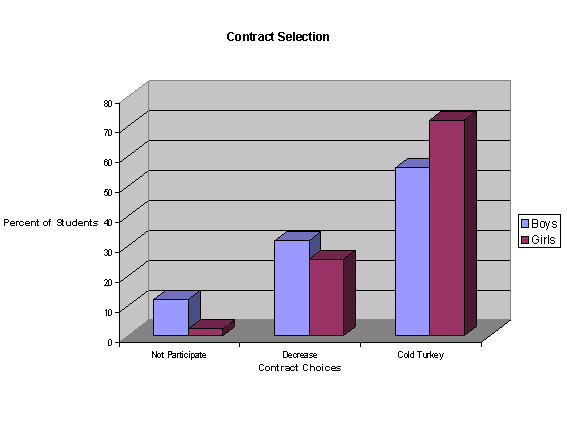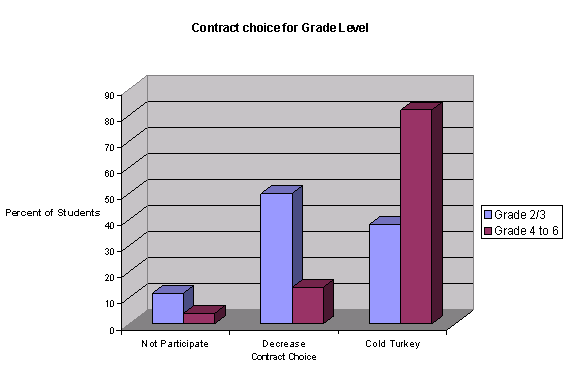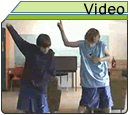|
Our curriculum was developed to be used in the elementary school system. The
pilot project consisted of eight classes of students for a
total of 178 students, 91 male students and 87 female students.
The students were selected from four different schools in
North Vancouver, British Columbia, Canada. The students ranged
from grade 2 to grade 6. Parental participation was an important
element of the project as well, so information packages, pamphlets,
surveys and newsletters were sent home throughout the project.
This
report has so far described how a group of North Vancouver
primary grade students have adjusted to the media saturated
lifestyle of today. But the most important goal of this
pilot project was also to establish whether a media risk education
programme (http: programme description) delivered to primary
school children through the schools could reduce the health
and safety risks associated with heavy media consumption.
The media education programme was designed not only to communicate
to North Vancouver families about the lifestyle risks associated
with excessive media consumption, but also to do so in a way
that made tuning out the screen a cool thing to do. So how
did the students respond to the challenge? Did they actually
use media less during tune out week?
Taking the Challenge
The ‘tune out’ challenge was accepted enthusiastically.
Of the 121 students who kept a record of tune out week activities,
we found that sixty percent of the students reported getting
through Tune Out Week without using screen entertainment (TV
and VCR, computer games, video games) at all. Girls were slightly
more enthusiastic (62% vs. 54% for boys) thought older boys
(grades 4-6) were far more successful than younger ones (63%)
compared with 41% of younger ones. The opposite was true for
girls as 65% younger in grades 2-3 were ‘media free’
compared with 59% of older girls.
Interestingly most students considerably reduced their media
consumption during Tune Out Week. In these classes the time
devoted to screen entertainment dropped to only17 minutes
a day. This amounts to an 80% reduction in media consumption
during tune out week for those students in the programme.
Although gender differences were not significant, it was
noted that boys averaged 21 minutes screen time during Tune
Out, while girls watched 14 minutes. Children in the lower
grades watched slightly more than older children (19 minutes
vs. 15 minutes) although closer analysis of the gender differences
by grade level revealed that it was the grade 2-3 boys who
engaged in screen entertainment most during Tune Out Week
(29 minutes) while the youngest girls did so least (12 minutes).
Grades 4-6 boys averaged 17 minutes compared with the 15 minutes
for the older girls. Even the 40% of students that continued
to watch and play during the week reduced their screen time
to 42 minutes which is still considerably less than the 117
minutes average daily use observed during the audit week.
Displaced Activities
The ‘displacement effect’ was estimated by subtracting
the amount of time spent using media in Tune Out Week from
that during audit week. The net effect was that students gained
100 minutes a day of leisure time from reducing their dependency
on screen entertainment. Those that tuned out gained 35 minutes
more than those that didn’t, but all children seemed
to benefit from the challenge.
The programme did seem to have a greater impact on the grades
4-6 students who gained 117 minutes compared with 79 minutes
for the grades 2-3 students. Those in grades 2/3 that tuned
out gained on average 90 minutes while those that didn’t
gained only 66 minutes. Those grade 4-6 students who tuned
out gained 133 minutes compared with 92 minutes for those
that continued to use media.

Evidence gathered in the form of contracts for the ‘Tune
Out the Screen Challenge’ revealed that the contract
process was important for the success of the challenge: 64%
of the children chose to go cold turkey, 29% adopted a ‘controlled
use’ approach, and less than 7% ‘opted out’
the challenge. Analysis showed that the ‘controlled
use’ strategy was far more popular among the younger
students where as the ‘cold turkey’ strategy was
chosen by 82% of the older ones who seemed to take up the
‘challenge’ more enthusiastically. It was noted
that those refusing to take the ‘tune out challenge’
were disproportionately boys (83%) and also were far more
likely to be from grade 2 and 3.
Of those that adopted a controlled use approach, 56% chose
to allot themselves a time limit (average 1 hour) while 44%
chose to only watch their favourite programmes.

Chi Square P> .001
This is not to say that all those that signed the contract
did not use media during ‘Tune Out Week’. But
the contract made a difference: Of those that chose cold turkey,
76% made it through the week without media; of those agreed
to controlled use, 33 % made it through the week without media;
of those that opted out, one actually reported not using the
media during the challenge week.
Taken together, the study provided strong evidence
that those students who made a greater commitment actually
watched less during tune out week (Not participating
– 28 minutes, decrease time- 23 minutes and cold turkey
time- 5 minutes); gained more leisure time (Not participate-
97 minutes, decrease time- 90 minutes and cold turkey- 109
minutes); and increased their total free time activities
more (Not participate- 3 minutes, decrease time-
4 minutes and cold turkey – 4 minutes) compared with
those that made no commitment.
The ‘cold turkey’ group consumed media on average
only 5 minutes a day during tune out week, gaining 109 minutes
of leisure time, and participating in 4.3 activities whereas
the ‘opt out’ group consumed 27 minutes and gained
97 minutes, and participated in 3 alternate leisure activities.
The ‘controlled use’ group used media for 22 minutes
per day on average and gained 90 minutes of leisure time,
although this was dramatically different for the younger students
(who only gained 64 minutes) when compared with the older
students (153 minutes gained). Again it was those ‘opted
out’ younger boys who consumed the most media during
Tune Out Week (38 minutes).
So what did those who participated in the Tune Out Challenge
do with the discretionary time they gained. The analysis of
65 tune out week diaries indicates that sports and outdoor
play was the most frequent activity accounting for 34% of
their responses. Indoor play and hobbies(19%), eating (15%),
homework (14%) and media (8%) accounts for more than half
their recorded time. Reading 6%, and just resting/ ‘vegging
out’ (2%) accounts for the rest of their discretionary
time. Sleeping, travel and self-maintenance time were eliminated
from this analysis. It was noted that active leisure is much
more common in the after school hours than in the evening.
Evidence from this pilot study showed that all students,
whether they used media or not during the tune out week preferred
active outdoors sports and play. Since all students gained
discretionary time, there was no evidence that those who ‘tuned
out’ spent more time in physically active leisure than
those that watched, although there was some evidence that
those that tuned out completely did undertake in indoor play
and hobbies (30% vs 23% of activity responses) and reading
(13% vs 7%) more frequently. Overall the impact of the programme
seemed to be that all children were willing to try out new
activities, or to spend more time doing what the enjoyed most.
The verbatim accounts of their Tune Out experiences give
a clear sense of how the programme encouraged children to
explore ‘unscreened’ leisure activities more.
Reversing Dependency (* students opted to
not participate in Tune Out Week)
Their descriptions about their experience of the tune out
challenge revealed that for some kids, tuning out was like
breaking a bad habit.
"It was hard without any media,
but I still had some fun. First I took out the batteries
in my TV, then I unplugged my computer. Then I played scrabble
and checkers with my grandpa. Then I played hockey, outside.
I didn't watch or do any media today". Grade
5/6 Boy
"I was tempted to go on the computer
because my brother was playing my favourite game, but I
read a book with my mom to take my mind off it".
Grade 5/6 Girl
" Used no media. It's hard but
I'm doing good so far". Grade 4 Girl*
Monday" Today was quite strange without
the sounds of videogames, the computer, TV, and the radio.
I realized that without media, life can be quite fun and
entertaining. Instead of using media I read some books,
played outside and finished my homework early".
Tuesday" Without media the day
seemed longer. I had more time to study for my tests, more
time to play with my friends, and more time to read books.
I think that the house seems very quiet without cartoons
on all day. Doing this doesn't seem so hard"
Grade 5/6 Girl*
" I didn't watch TV. I went outside
instead. I didn't miss the TV, but I did miss the computer.
I played go fish with my brother-it was sort of fun. I also
played with my dogs". Grade 5/6
Girl
" I could not help myself from
watching TV. But when my mom came home, I forgot all about
media tune out. So I watched a little TV, then went outside
to wash the car, then went for a walk". Grade
4 Girl*
Creating Alternatives
On the other hand, many children did not find it difficult
to find alternatives to the screen during the week and did
discover alternative leisure activities were both available
and pleasurable.
" I survived tune out week by
doing things outside like bike around and play basketball.
I didn't like anything on the TV anyway" Grade
5/6 Boy*
" Monday-- It was hard not watching
TV, not using media, and this is how I survived. When I
wanted to watch TV I just went in my room and I drew on
my sketch book. After I wanted to use my computer, I phoned
my friends to bike ride or play outside". Grade
5/6 Boy*
" It was really hard for me to
survive without media, but I used lots of things to help
me. I went outside and played. I also read books. I also
played my flute. Because I have a concert. Those are some
things I did to get away from media" Grade
5/6 Girl*
Peer Culture
Primary aged students are influenced by their peer culture.
If their friends are talking about video games and media then
they want to in order to fit in. But if their peer group supports
active leisure then being social means participating in those
activities too. In the Tune Out Week verbatim we have some
evidence that part of the success depended on perception that
kids could arrange to do other activities with their friends
Social analysis
"I had no problem without media.
My friend Kevin and I started on a rock quiz book. We went
outside and took a break from our rock project. We had a
great day without media". Grade 5/6 Boy*
" I watched no TV. Instead I played
with my friend" Grade 4 Girl
" I did not watch any TV because
I wanted to go to the park with my friend then I ended up
playing at another friend's house and we made a slide on
her staircase. I think tune out the screen media week is
really fun so far". Grade 4 Girl*
Other Effects
Interviews with the teachers confirmed that not only did
the students get excited about the programme, but that the
effect of tuning out had a positive impact on their classroom.
One teacher described a calming effect, remarking on the absence
of disruptive behaviour as a refreshing change from the usual
atmosphere in her classroom. Another talked about the completion
of homework and the solidarity that developed in her class
as the students coalesced around taking the ‘challenge’
together. The principles review of the behaviour reporting
system in EBS schools revealed that there were not incidences
of bullying in a school during tune out week, when on average
there are x reports.
In order to assess whether reduced media consumption and
increased active leisure had any impact on the children’s
play behaviour, three observers undertook qualitative observations
of about 15 students on the playground during recess at one
school. Mostly the students formed into two loose clusters
at recess (one group of grade 2-3 students and the other,
a group of 5 or 6 boys from grade 4/5. These students were
observed on the playground during three separate recess breaks
over a period of three consecutive weeks and their activities
were recorded for the time period before Tune Out Week (May
28th), during Tune Out Week (June 4th) and after Tune Out
Week (June 11th).
As in all groups the gender makeup of the playgroups, the
game, and the participants changed constantly over the period
of observation making comparison very difficult: yet there
is also a degree of routine (controlled chaos) the pervades
recess play, because loose clusters of children form regular
playful interactions often organized around specific routines.
One cluster of 3-5 younger children (grade 2/3) spends most
of their time around the swing area while a group of 4-6 boys
from grade 4/5 spends their time in the chain bridge area,
which is located directly across the swing area. The groups
do not largely interact across grade and gender lines.
Over three weeks the younger mixed gender group spends most
of the recess time at the swing competing with each other
to see who can swing higher or jump farther.
Although physical conflict (pushing, hitting, tripping) is
not often observed among these younger children on the playground,
aggressive language, shouting and insults were often noted,
especially before tune out. Shouting and screaming is a common
part of games, and children constantly offer other players
both helpful cries of “watch out!” and warnings
or threats “I’m going to slay you”. Conversation
between these kids is constant, and yelling is a frequent
accompaniment to their swinging contests, games of tag, and
role-play episodes although aggressive verbalizations are
often accompanied by laughing. Throughout the three weeks
their conflict remained playful, being more symptomatic of
exuberant active games than of regular bullying or intimidation.
It is in these verbalizations of their role play, that media’s
impact was sometimes noted. One group who had just seen the
movie pretended they were Harry Potter characters all recess.
Among the younger group it is not uncommon to here someone
to pretend to be a WWF wrestler or shout ‘I am Spiderman’
while swinging on a rope. Their role-play games were largely
unstructured consisted of conversations, which contained little
real conflict. Occasionally however, conflict from media is
expressed on the playground. For example, one child among
a group of older boys playing on the swing was using his hands
as a make-believe gun and shouting “bang bang”
noises. When asked he mentioned he imagined himself to be
a Soprano’s hit man he had seen who was taking out someone
he didn’t like. During the first week of the project
the researchers brought in a CD of movie themes, which included
songs from Friends, Pokemon, Hockey Night in Canada and Sopranos.
The students in the older classes did not know the Sopranos
theme music, but 3 kids from the grade 2 and 3 class knew
the theme song right away. One of the boys even sat up straight
and in a gruff voice proclaimed 'Oh Yah, I am Tony'.
Among the younger players especially, these taunts, poems
of insult, and rhyming rebuffs are considered fun and part
of the games these kids play, When not playing or conversing,
these children are inventing, negotiating, and enforcing the
rules for future play. For example one girl in the younger
group spent most of the recess explaining to another how to
play a version of what she called ‘Dragon’ tag.
The other asked questions about how different situations were
resolved. Although they did not end up actually playing the
game the rules were now passed on, and several weeks later
the girls were noted playing what was called ‘dragon
tag’.
Across the swing area is the chain bridge area where the group
of older boys hangs out most of the time. This group regularly
engages in highly competitive rough and tumble games on the
chain bridge, the most frequent which is a version of ‘king
of the castle’ where one player holds precarious ground
while fighting off others who are trying to knock each other
off. They claimed their game was modeled on American Gladiators.
This group of older boys did a fair bit of ‘rough housing’
as they used the chain bridge (part of the playground facility)
as their battle arena for American Gladiators. Two of the
children sit on top of the beam waiting for their turn while
the other two children engaged in a rough-and-tumble assault
in which they try to bump each other off the rope that they
are holding on to. Two other boys are also waiting for their
turn, but also engaging in the play by sitting on top of the
beam and swinging the rope to make the game tougher for the
two competitors. Even though these boys are engaged in constant
physical contact (tackle, pushing) they all seemed to be very
happy and no real fighting or any physical confrontation or
anger is observed among them.
Conflict
The need for agreed rules of play is accepted by all on the
playground, but occasionally conflict does occurs, resulting
from failed negotiations over play, or when individuals break
into an ongoing game in a disruptive way. For example, in
the first week it was observed that one young boy who always
wanted to be “it” intruded into a group of girls
playing tag. This generated a certain amount of tension among
the tag players. Two girls tried their hand at explaining
the rules of their game of tag to no effect. Realizing their
tag game was being effectively obstructed by this male player
who wanted to turn their game of tag into ‘chase the
girls’ a few went to the ‘home safe’ area
to have a conversation. Although the players were obviously
miffed at having their group play disrupted no physical confrontation
or angry words were exchanged. During the three weeks observations
although energy levels remained high, there was little evidence
of persistent bullying or physical conflict among this group
of young elementary.
During week one as well towards the end of recess another
incident occurred when a boy from the swinging group (who
used a stick as gun and wanted to be ‘it’) became
very interested in the older boys game on the bridge. The
younger boy accompanied by a friend tried to join in without
getting the other players consent to be part of the game by
bumping an older player off the rope. The older boys responded
more aggressively to this young player, than they have been
with each other. Pushing kicking and tripping breaks out as
an angry shouting match is joined by the other older players.
When the recess bell rang, the older boys ran back to their
class leaving the one young intruder crying on the playground.
During tune out week there are only slight variations in
both groups play behavior. The children of group 1 remained
in their swing area, competing for height perhaps with less
shouting and rivalry than the week before. Most of the recess
is spent in conversation and teasing. The older group play
on the same chain bridge area but this week one of the boys
has made a paper plane which he begins flying when he comes
out of class. Because the plane becomes crumpled during the
gladiatorial contest, the boys break off from the competition
to have a funeral for the plane, burying it and then putting
a flower on top of the mound. Then several of the boys saw
two girls at a bulletin board outside the fence of the playground.
They went over and helped them to redecorate the bulletin
board until a teacher asked them to come back inside the school
ground. The group cooperated without hesitation and continue
to converse rather than return to their game.
During the final week of observation, the younger students
were in the swing area. A mixed group spends the recess swinging
high and chatting. Two other boys are talking to each other
while using two swings as beds, rather than competing. Another
group were lying on the swing facing down and winding them
up to twist them in a circular motion. They then (perhaps
dizzy) begin running across the playground and back to the
swing. No acts of aggression were observed in either of these
weeks and the children seem to be mellower. Yelling and shouting
are also more subdued than previous two weeks. No incidences
of conflict are observed confirming the teachers suspicions
that the groups seemed to ‘chill out’ during tune
out week.
Although the data from this pilot study is anecdotal, it
provides telling evidence of the potential of this media risk
reduction intervention. Once they tried it, reducing media
consumption seemed easy enough, and the alternative of active
play proved more fun.
|







